Servicios Personalizados
Revista
Articulo
Indicadores
-
 Citado por SciELO
Citado por SciELO -
 Accesos
Accesos
Links relacionados
-
 Similares en
SciELO
Similares en
SciELO
Compartir
Revista mexicana de ciencias agrícolas
versión impresa ISSN 2007-0934
Rev. Mex. Cienc. Agríc vol.10 no.8 Texcoco nov./dic. 2019 Epub 05-Feb-2021
https://doi.org/10.29312/remexca.v10i8.1558
Articles
Inoculation of phosphorus solubilizing fungi and arbuscular mycorrhizae in tomato plants
1Instituto Tecnológico Superior de Xalapa. Reserva Territorial s/n, Col. Santa Bárbara, Xalapa, Veracruz, México.
2Facultad de Ciencias Agrícolas-Universidad Veracruzana-Campus Xalapa. Circuito Gonzalo Aguirre Beltrán s/n, Zona Universitaria, Xalapa, Veracruz, México. CP. 91090.
3Facultad de Biología-Universidad Veracruzana-Campus Xalapa. Circuito Gonzalo Aguirre Beltrán s/n, Zona Universitaria, Xalapa, Veracruz, México. CP. 91090.
The need to reduce the use of chemical fertilizers demands the creation of alternative strategies that maintain competitive plant production without deteriorating the environment. In this study, the effectiveness of the inoculation of mycorrhizal fungi and phosphorus solubilizers (alone and in consortia) on mycorrhization, the phosphorus content in the aerial part, the height, and root length of tomato plants was evaluated. Treatments included three strains of solubilizing fungi (Aspergillus niger, Penicillium brevicompactum and Penicillium waksmanii), a consortium of mycorrhizae and all possible combinations including a control (without fungi). After four months, the mycorrhizal colonization, the phosphorus content of the aerial part was quantified by the molybdate blue method and the variables height and root length. The results obtained showed a colonization range of 48-66%; the highest values were detected with the AMF and AMF + An treatments. The consortium treatments of PSF and PSF + AMF showed a 191% increase in foliar phosphorus compared to the controls. The height of tomato plants was significantly greater in all treatments compared to the control. For the root length the AMF treatment and the control presented the highest values. The phosphorus solubilizer fungi consortiums in combination with the mycorrhizal fungi consortium have a high potential to be used as tomato biofertilizers in the greenhouse.
Keywords: Aspergillus niger; Penicillium brevicompactum; Penicillium waksmanii; biofertilization; consortia; mycorrhizal colonization
La necesidad de reducir el uso de fertilizantes químicos demanda la creación de estrategias alternativas que mantengan una producción vegetal competitiva sin deterioro del ambiente. En este estudio, se evaluó la efectividad de la inoculación de hongos micorrícicos y solubilizadores de fósforo (solos y en consorcios) sobre la micorrización, el contenido de fósforo en la parte aérea, la altura, y longitud de la raíz de las plantas de jitomate. Los tratamientos incluyeron tres cepas de hongos solubilizadores (Aspergillus niger, Penicillium brevicompactum y Penicillium waksmanii), un consorcio de micorrizas y todas sus posibles combinaciones incluyendo un testigo (sin hongos). Después de cuatro meses, se cuantificó la colonización micorrícica, el contenido de fósforo de la parte aérea por el método del azul de molibdato y las variables altura y longitud de raíz. Los resultados obtenidos demostraron un rango de colonización del 48-66%; los valores más altos se detectaron con los tratamientos de HMA y HMA + An. Los tratamientos consorcios de HSF y HSF + HMA exhibieron 191% de incremento del fósforo foliar respecto a los testigos. La altura de las plantas de jitomate fue significativamente mayor en todos los tratamientos con respecto al testigo. Para la longitud de raíz el tratamiento HMA y el testigo presentaron los valores más altos. Los consorcios de hongos solubilizadores de fósforo en combinación con el consorcio de hongos micorrícicos tienen un alto potencial para ser utilizados como biofertilizantes de jitomate en invernadero.
Palabras clave: Aspergillus niger; Penicillium brevicompactum; Penicillium waksmanii; biofertilización; colonización micorrícica; consorcios
Introduction
In the soil, the amount of P available to plants depends on the modification of the dynamic equilibrium that maintains the dissolution of insoluble inorganic compounds and the decomposition of organic matter (Navarro, 2003). These processes are carried out by soil microorganisms, through a series of physical-chemical and biological reactions. Approximately 10% of the soil microbial community actively transforms the P through the processes of mineralization, solubilization, immobilization and oxidation (Alexander, 1980; Coyne, 2000; Reyes, 2011).
Rhizospheric microorganisms such as arbuscular mycorrhizal fungi (AMF) and phosphorus solubilizing fungi (PSF) are of particular importance for plants and soil fertility, on the one hand, PSF promote phosphorus availability (Jeffries and Barea 2001), while AMF facilitate their transportation to the plant (Ferrol et al., 2002). Inoculation of solubilizing fungi is a promising technique, since increases in the yield of wheat (Whitelaw et al., 1997), onion (Vassilev et al., 1997) and soybean (El-Azouni, 2008) have been reported.
Additionally, other studies show a better development and productivity of plants using mixtures or consortia of phosphorus solubilizing fungi (Shin et al., 2006; Mittal et al., 2008). Studies on AMF have shown that these fungi not only act in the development and growth of the plant, but also contribute to the protection against pathogens (Bañuelos et al., 2014). Several investigations (Fernández et al., 2006; Mujica, 2012; Mujica and Batlle, 2013; Velázquez et al., 2017) have described that the synergism between these two groups of fungi (PSF and AMF), can have a better development of the plants that when inoculated alone.
The cultivation of tomatoes in Mexico is one of the most important, during 2015, tomato was the most important product in the value of Mexican agricultural exports, with a 13% share, being located at 1 665.8 million dollars and 1.43 million tons. The volume exported during that year was equivalent to 53.3 percent of the national production of this vegetable. The availability of new types and varieties, new cultivation methods and the growing demand for vegetables have encouraged the global production of red tomatoes.
The volume harvested worldwide, the total consumption, as well as the average per capita consumption register an upward trend during the recent decade. China remains the leading producer and consumer. The United States of America is the main world importer, while Mexico is the main external supplier (SAGARPA, 2018). This vegetable demands large amounts of nitrogen, phosphorus and potassium; these fertilizers, when applied in doses higher than the crop requirements, lead to low utilization (Peña-Cabriales et al., 2001), contamination of the soils (Castellanos and Peña-Cabriales, 1990) and of the aquifers, as well as the eutrophication of surface waters (Nebel and Wright, 1996).
In this context, the use of microorganisms duly selected for their efficiency and generated from local resources, constitutes an ecologically acceptable alternative to reduce external inputs and improve the quantity and quality of internal resources. This study arises from the interest of investigating at greenhouse level the interactions of native PSF and AMF for the biofertilizer approach; from fungal consortia that promote the availability and transport of insoluble phosphorus to tomato plants.
Materials and methods
Tomato seeds (Lycopersicon esculentum Mill.) prior to germination were disinfected with 50% commercial Cloralex® (15 min). The seedlings were transferred to 250 g pots with sand and sterile perlite 1:1 (v/v), each one was added tricalcium phosphate as an insoluble source of phosphorus (0.125 g), the inoculum of AMF (10 g) and the inoculum of each of the PSF strains (1 x 108 CFU mL-1) as proposed by Souchie et al. (2010). The inoculants were applied directly to the substrate and to the plant’s root system.
An experimental design of two factors with five levels was established, in total 10 treatments with three repetitions, this is 30 experimental units. Treatments included: a consortium of AMF, three strains of PSF (Aspergillus niger Tiegh, Penicillium brevicompactum Dierckx and Penicillium waksmanii K.W. Zaleski) and all possible combinations including a control (without fungi).
The strains of PSF used: A. niger (An), P. brevicompactum (Pb) and P. waksmanii (Pw) belong to the collection of the Micromycete Laboratory of the Institute of Ecology, which were isolated from soils in the center region from the state of Veracruz, Mexico and were selected for their high capacity to solubilize tricalcium phosphate. The AMF consortium belongs to the collection of the laboratory of beneficial organisms of the Faculty of Agricultural Sciences of the Veracruzana University. The species that make up this consortium were isolated from soils in the Xalapa region and its surroundings in the state of Veracruz.
The AMF inoculum contained 60 spores g-1 of substrate integrated with root fragments with 79% colonization, composed of the species of Acaulospora morrowiae (Spain and NC Schenck), A. spinosa (C. Walker and Trappe), A. scrobiculata (Trappe), Gigaspora rosea (TH Nicolson and NC Schenck), Scutellospora pellucida (TH Nicolson and NC Schenck) C. Walker and FE Sanders, Glomus macrocarpum (Tul. and C. Tul.), Funneliformis mosseae (TH Nicolson and Gerd.) C. Walker and A. Schüßler, F. geosporum (TH Nicolson and Gerd.) C. Walker and A. Schüßler and Rhizophagus aggregatus (NC Schenck and GS Sm.) C. Walker.
The experiment was maintained for four months (May-August 2015) in a greenhouse at the Institute of Ecology, AC. Watering was done by capillarity and 25 mL of Hewitt's nutrient solution (Hewitt 1969) without phosphorus was added weekly. After that time, the plants were harvested, to measure the height and root length, percentage of mycorrhizal colonization and total phosphorus of the area part of the plants.
Mycorrhizal colonization. The clearing and staining of roots were carried out using the technique of Phillips and Hayman (1970). To do this, the roots were washed with plenty of water, then cut into small pieces and placed in tubes with 10% KOH, immediately subjected to a water bath for 15 min. After that time the KOH was removed and washed with water. They were then added 10% HCl and kept in that reagent for 10 min. Then, they were washed with water and 0.05% trypan blue was added and left in a water bath for 10 min.
Excess trypan blue was removed and placed in tubes with lactic acid until observation. To determine the percentage of plant root colonization, the technique described by Giovannetti and Mosse (1980) was used, which consisted of placing the roots stained with trypan blue in a squared Petri dish (1 cm x 1 cm) with lactic acid and fungal structures were observed under the stereoscopic microscope. The percentage of mycorrhizal colonization was calculated by dividing the total number of mycorrhized root interactions, over the total number of intersections, multiplying the result by 100.
Measurement of total foliar phosphorus. 0.25 g of dried foliar plant material were taken and calcined in a muffle at 500 °C for 2 h (Mckean, 1993). The ashes were dissolved in distilled water and the phosphorus concentration was determined through the molybdate blue method (Murphy and Riley 1962). The samples were measured on a spectrophotometer at 660 nm absorbance.
Plant growth variables. Height was measured from the root neck to the apical meristem and the root length from the root neck to the root meristem.
Statistical analysis
First, the assumption of normal distribution and homogeneity of variance of the data was verified by Kolmogorov-Smirnov and Bartlet tests. To detect differences in mycorrhization between treatments, a one-way analysis of variance and Tukey’s means tests were used. In addition, in order to detect a significant interaction between the phosphorus solubilizing fungal factor and the mycorrhizal factor, factorial variance analyzes were performed. When the interaction data were significant, Tukey’s means tests were performed. All analyzes were performed in the Statistica version 10.0 program for Windows.
Results and discussion
The results of mycorrhizal colonization in this study show a significant variation between the different treatments evaluated (p= 0.000) (Figure 1). Mycorrhizal colonization in tomato plants inoculated with mycorrhizal fungi and phosphorus solubilizers was in the range of 48-66% colonization, which confirms the high micotrophy of the plant, as demonstrated in other studies.
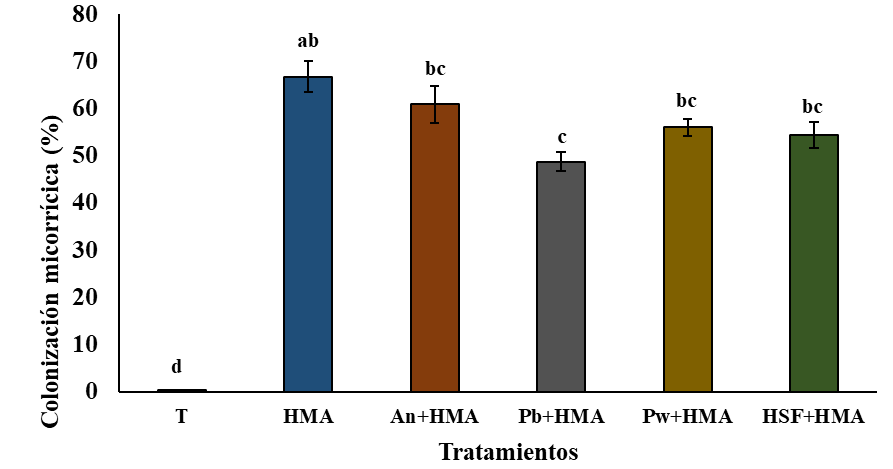
Figure 1 Percentage of mycorrhizal colonization of tomato plants after 4 months inoculated with treatments. T= control; AMF = arbuscular mycorrhizal fungi; An= Aspergillus niger; Pb= Penicillium brevicompactum; Pw= Penicillium waksmanii; and PSF= phosphorus solubilizing fungi. n= 3; ± standard deviation. Identical letters between the columns indicate that there are no significant differences between treatments (Tukey LSD, p≤ 0.05).
Compared to other investigations in which mycorrhizal colonization was evaluated in tomato plants inoculated with AMF, this work found greater colonization than that reported by Velazquez et al. (2005), who detected 30-50% mycorrhizal colonization; Mujica and Fuentes (2012) of 40-47% and Mujica and Batlle (2013) 58% of colonization. The mycorrhizal colonization in this study was analyzed by the presence of arbuscles, vesicles and spores; it is important to note that high sporulation was observed inside and outside the roots (Figure 2).
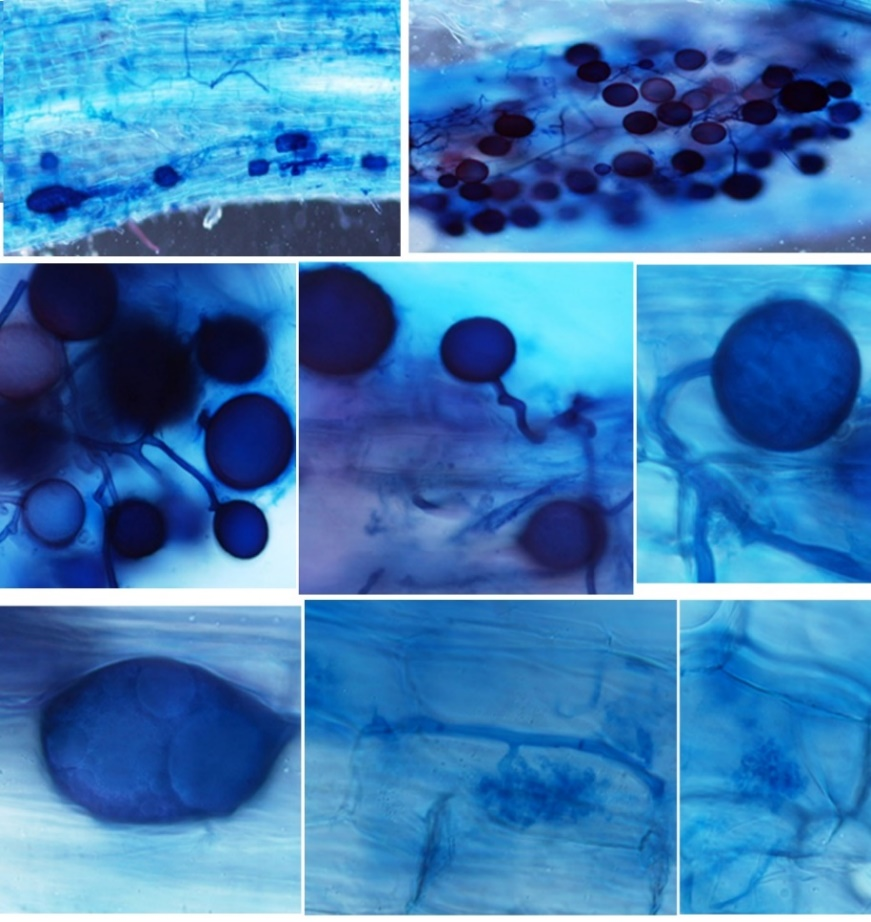
Figure 2 Mycorrhized tomato roots at four months after inoculation. A) germinated spores inside and outside the roots; B) spores; C) vesicle; and D) arbuscles.
The tomato plants inoculated with the AMF + An treatment was significantly larger than the Pw (t= 0.006), Pb (t= 0.0002) and PSF + AMF (t= 0.002) treatments (Figure 1). This result suggests a synergism between the AMF consortium and the phosphorus solubilizing strain A. niger.
There are studies that confirm that inoculation of saprobic fungi favors the colonization of AMF in crops such as chili with Claroideoglomus claroideum with Penicillium albidum and Penicillium frequentans (Castillo et al., 2013), in tomato with Glomus mosseae (Funneliformis mosseae) and A. niger (Velazquez et al., 2005), in clover with Glomus clarum (Rhizophagus clarus) and Glomus geosporum (Funneliformis geosporum) with A. niger (Souchie et al., 2010); in bamboo with Glomus spp. Aspergillus tubingensis (Babu and Reddy, 2011).
In this work with tomatoes, an increase in mycorrhizal colonization was not observed in the presence of A. niger, P. brevicompactum and P. waksamnii so it is recommended to continue evaluating the effectiveness of other strains of PSF in order to detect any that favor greater mycorrhizal colonization.
Total foliar phosphorus
For the total foliar phosphorus of tomato plants, a significant interaction was detected between the PSF and AMF factors (p= 0.000). All treatments had a higher concentration of total phosphorus with respect to the control (t< 0.05). The PSF treatment was significantly higher than the rest of the treatments (t< 0.05) (Figure 3). The total phosphorus concentration in the aerial part of tomato plants ranged from 450 to 700 mg kg-1. Consortium treatments (PSF and PSF + AMF) exhibited the greatest increases (191%) in phosphorus compared to the control.
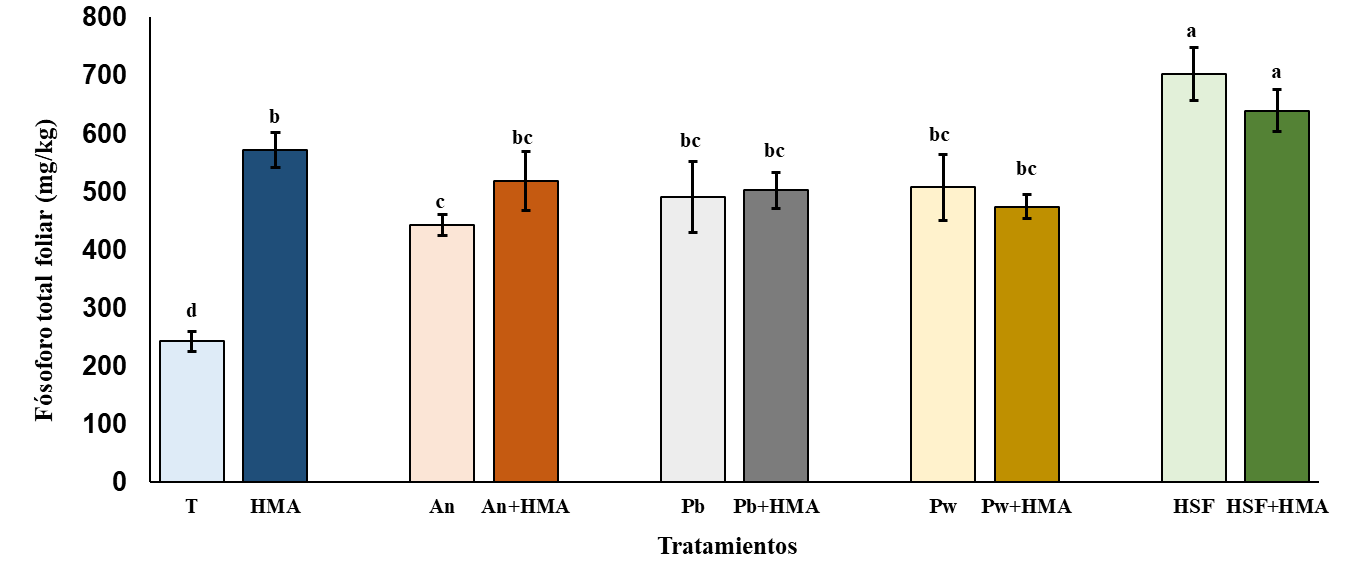
Figure 3 Total foliar phosphorus of the aerial part of tomato plants after four months inoculated with the treatments. T= control; AMF = arbuscular mycorrhizal fungi; An= Aspergillus niger; Pb= Penicillium brevicompactum; Pw= Penicillium waksmanii; and PSF= phosphorus solubilizing fungi. n = 3; ± standard deviation. Identical letters between the columns indicate that there are no significant differences between treatments (Tukey LSD, p≤ 0.05).
This increase was higher than those reported in other similar studies under greenhouse conditions. Souchie et al. (2006) did not detect increases in foliar P in Trifolium after inoculating G. mossae (Funneliformes mosseae) and Aspergillus niger. On the other hand, Rodríguez-Cabral et al. (2012) found a 20% increase in this variable in cashew nuts, also inoculated with these fungi, Velázquez et al. (2005).
They report a 78% increase in total foliar phosphorus in tomato inoculated with G. mosseae (Funneliformes mosseae) and A. niger; Zhang et al. (2014) obtained 100% increases in a herbaceous plant (Kosteletzkya virginica) inoculated with G. mosseae (F. mosseae) and Mortierella sp., Babu and Reddy (2011) detected 115% increase in foliar phosphorus in bamboo plants after of the co-inoculation of a consortium of AMF and Aspergillus tubingensis, Zhang et al. (2014), on the other hand, detected a greater increase (300%) in foliar phosphorus in castor plants inoculated with G. mosseae (F. mosseae) and Mortierella sp.
The combination of the inoculation of these two groups of fungi (AMF and PSF) can produce greater phosphorus absorption (Barea et al., 2008) and increase the development of the plants mainly due to the nutritional effect that this combination provides, however there are other mechanisms by which fungi could affect plant development, such is the case of an improvement in soil structure (Khan, 1993), increase in soil moisture (Camargo-Ricalde, 2002), stress tolerance induction environmental (Cantrell and Linderman, 2001), higher photosynthetic rate (Finlay, 1992), among other effects than the nutritional ones reported.
Plant growth variables
For the height variable, a significant interaction between the PSF and AMF factors (p= 0.01) and a significant effect of the PSF factor (p= 0.004) were detected. However, the effect of the AMF factor was not significant (p= 0.35). The height was significantly higher in all fungal treatments with respect to the control (Figure 4). The range of average values of the heights (51-81cm) are higher than those reported by Velázquez et al., 2005 in tomato plants (42.3 cm) with double inoculations of G. mossae (Funneliformes mosseae) and a strain of A. niger.
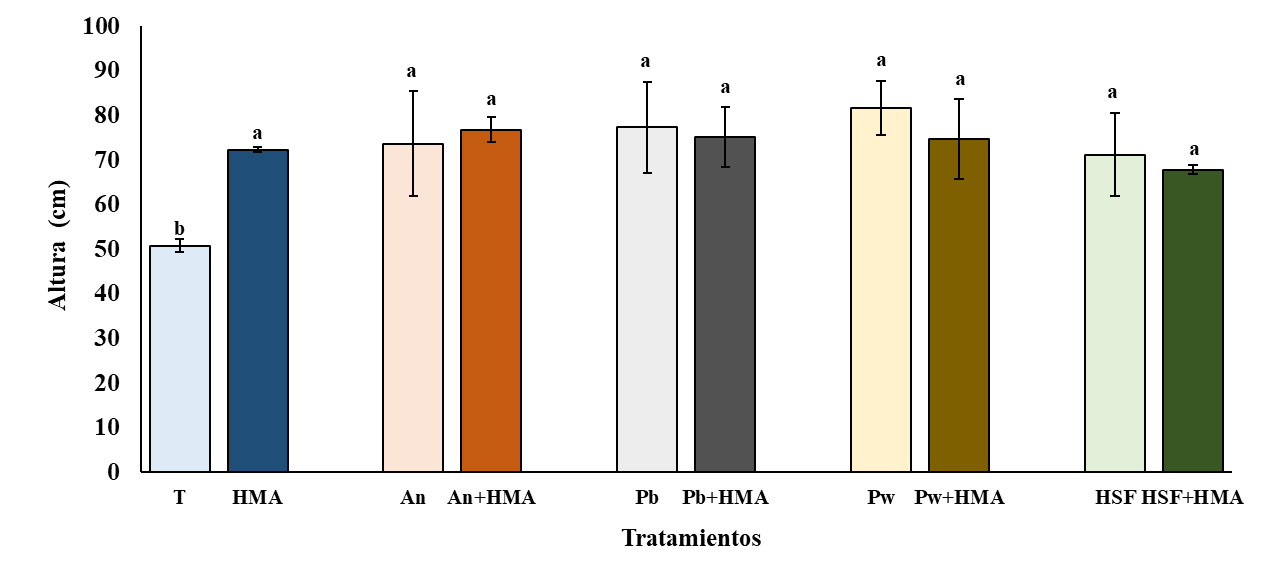
Figure 4 Height of tomato plants after four months of inoculation with treatments. T= control, AMF= arbuscular mycorrhizal fungi, An= Aspergillus niger; Pb= Penicillium brevicompactum; Pw= Penicillium waksmanii; and PSF = phosphorus solubilizing fungi. n = 3; ±standard deviation. Identical letters between the columns indicate that there are no significant differences between treatments (Tukey LSD, p≤ 0.05).
In other studies, it has also been observed that double inoculations of AMF and PSF favor plant height (Babu and Reddy, 2011; Castillo et al., 2013). For the root length of tomato plants, a significant interaction between PSF and AMF factors was detected (p= 0.03). No significant effect of the AMF factor was observed (p= 0.93); however, if there is with the PSF factor (p= 0.000). Plants with AMF and control treatments showed significantly longer roots than with Pb + AMF, Pw + AMF and PSF (t< 0.05) (Figure 5).
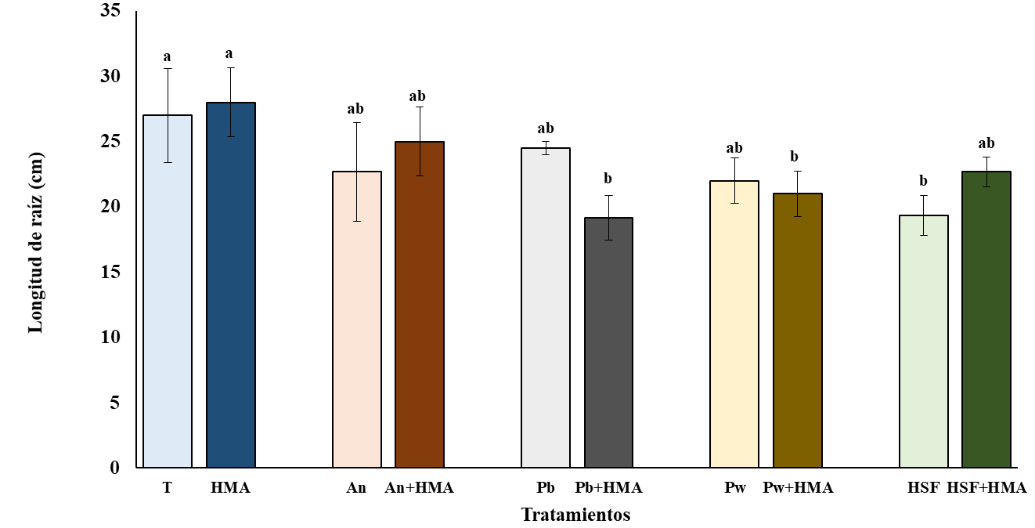
Figure 5 Root length of tomato plants after 4 months of inoculation with treatments. T= control; AMF= arbuscular mycorrhizal fungi; An= Aspergillus niger; Pb= Penicillium brevicompactum; Pw= Penicillium waksmanii; and PSF= phosphorus solubilizing fungi. n = 3; ±, standard deviation. Identical letters between the columns indicate that there are no significant differences between treatments (Tukey LSD, p≤ 0.05).
The high root length values of the control plants could be due to the fact that, given the low availability of nutrients in which the plants were found, the roots extended in search of nutrients (Barea et al., 2008). The root length of the plants inoculated with the PSF consortium (better treatment in the availability of phosphorus in the aerial part) presented lower values, probably due to the inoculation with the PSF consortium by providing a higher concentration of nutrients to the plant, elongation of the root was not necessary since the nutrients were found directly for the plants (Barea et al., 2008).
The strains used are native to the region, the AMF consortium had already been tested and demonstrated its efficiency in other crops (Ferrera et al., 2007; Sangabriel-Conde et al., 2010; Bañuelos et al., 2012; Zulueta- Rodríguez et al., 2013; Bañuelos et al., 2014). On the other hand, the strains A. niger, P. brevicompactum and P. waksmanii are also native to the soils of the central region of Veracruz, their capacity as solubilizers of calcium phosphate under in vitro conditions had already been demonstrated (Perea, 2019).
It is important, to influence producers on the use of these native fungi as an alternative for the application of biofertilizers, thus adopting new strategies that will increase awareness of environmental care, a reduction in production costs, soil conservation and recovery, as well as maintaining biodiversity (Fernández and Rodríguez, 2005).
Conclusions
The inoculations of the PSF and AMF consortiums worked synergistically, the AMF and AMF + An ratio led to a high percentage of mycorrhization, the interaction of PSF and AMF increased phosphorus availability and transport in tomato plants and the heights of the plants were increased with all fungal treatments.
Acknowledgments
This study was funded by CONACYT (C01-0194) CONACYT Project ‘Application of fungal interactions in soil restoration and fertilization’ (2011/169124) developed at the Institute of Ecology, AC. The authors thank MC Yamel del Carmen Perea Rojas and Engineer Noemi Orozco Domínguez for her help in processing the samples.
REFERENCES
Alexander, M. 1980. Introducción a la microbiología del suelo. Libros y Editoriales, SA. México, DF. 49 p. [ Links ]
Babu, A. G. and Reddy, M. S. 2011. Dual inoculation of arbuscular mycorrhizal and phosphate solubilizing fungi contributes in sustainable maintenance of plant health in fly ash ponds. Water, Air and Soil Pollution. 219(1-4):3-10. [ Links ]
Bañuelos, J.; Alarcón, A.; Larsen, J.; Cruz-Sánchez, S. and Trejo-Aguilar, D. 2014. Interactions between arbuscular mycorrihizal fungi and Meloidogyne incognita in the ornamental plant Impatiens balsamina. J. Soil Sci. Plant Nutr. 14(1):63-74. [ Links ]
Bañuelos, J.; Trejo-Aguilar, D.; Alarcon, A.; Lara- Capistrán, L.; Moreira, C. and Cruz-Sánchez, S. 2012. The reduction in proline buildup in mycorrhizal plants affected by nematodes. J. Soil Sci. Plant Nutr. 12(2):263-270. [ Links ]
Barea, J. M.; Ferrol, N.; Azcón, C. and Azcón R. 2008. Mycorrhizal symbioses. In: the ecophysiology of plant- phosphorus interactions. White, P. J. and Hammond, J. P. (Eds). Springer. 142-163 pp. [ Links ]
Camargo-Ricalde, S. L. 2002. Dispersal, distribution and establishment of arbuscular mycorrhizal fungi: a review. Bot. Sci. 71:33-44. [ Links ]
Cantrell, I. C. and Linderman, R. G. 2001. Preinoculation of lettuce and onion with mycorrhizal fungi reduces deleterious effects of soil salinity. Plant and Soil. 233(2):269-281. [ Links ]
Castellanos, J. Z. y Peña-Cabriales J. J.1990. Los nitratos provenientes de la agricultura: una fuente de contaminación de los acuíferos. Terra. 8(1):113-126. [ Links ]
Castillo, C.; Morales, A.; Rubio, R. and Barea J. M. 2013. Interactions between native arbuscular mycorrhizal fungi and phosphate solubilizing fungi and their effect to improve plant development and fruit production by Capsicum annuum L. Afr. J. Microbiol. Res. 7(26):3331-3340. [ Links ]
Coyne, M. 2000. Microbiología del suelo: un enfoque exploratorio. Paraninfo. Madrid. España. 440 p. [ Links ]
El-Azouni, I. 2008. Effect of phosphate solubilizing fungi on growth and nutrient uptake of soybean (Glycine max L.) plants. J. Appl. Sci. Res. 4(6):592-598. [ Links ]
Fernández, F.; Dell, J. M. y Rodríguez, P. 2006. Efectividad de algunos tipos de inoculantes micorrízicos a base de Glomus hoi ‘like’ en el cultivo del tomate (Lycopersicon esculentum Mill. var. Amalia). Cultivos Tropicales. 27(3):25-30. [ Links ]
Fernández, M. y Rodríguez, H. 2005. El papel de la solubilización del fósforo en los fertilizantes microbianos. Sobre los derivados de la caña de azúcar. ICIDCA. 39(3):27-34. [ Links ]
Ferrera-Cerrato, R.; Alarcón, A.; Mendoza-López, M.; Sangabriel, W.; Trejo-Aguilar, D.; Cruz-Sánchez, J.; López- Ortiz, C. y Delgadillo-Martínez, J. 2007. Fitorremediación de un suelo contaminado con combustóleo utilizando Phaseolus coccineus y fertilización orgánica e inorgánica. Agrociencia. 41(8):817-826. [ Links ]
Ferrol, N.; Barea, J. M. and Azcón-Aguilar, C. 2002. Mechanisms of nutrient transport across interfaces in arbuscular mycorrhizas. Plant and Soil. 244(2):231-237. [ Links ]
Finlay, R. and Söderström, B. 1992. Mycorrhiza and carbon flow to the soil. In: Mycorrhizal functioning: an integrative plant-fungal process. Allen (Ed.) Chapman and Hall. 134-160 pp. [ Links ]
Giovannetti, M. and Mosse, B. 1980. An evaluation of technique for measuring vesicular arbuscular mycorrhizal infection in roots. New Phytologist. 84(3):489-500. [ Links ]
Hewitt, E. 1969. Sand and water culture methods used in the study of plants nutrition. Technical communication. 2da . (Ed.). Commonwealth Agricultural Bureaux. Inglaterra. 73 p. [ Links ]
Jeffries, P. and Barea, J. M. 2001. Arbuscular mycorrhiza-a key component of sustainable plant-soil ecosystems. In: the mycota (a comprehensive treatise on fungi as experimental systems for basic and applied research). Hock, B. (Eds.). Fungal Associations. Springer, Berlin, Heidelberg. 9:95-113. [ Links ]
Khan, A. 1993. Occurrence and importance of mycorrhizae in aquatic trees of New South Wales, Australia. Mycorrhiza. 3(1):31-38. [ Links ]
Mckean, S. 1993. Manual de análisis de suelos y tejido vegetal: una guía teórica y práctica de metodologías. 9-10 p. [ Links ]
Mittal, V.; Singh, O.; Nayyar, H.; Kaur, J. and Tewari, R. 2008. Stimulatory effect of phosphate solubilizing fungal strains (Aspergillus awamori and Penicillium citrinum) on the yield of chickpea (Cicer arietinum L. cv. GPF2). Soil Biol. Soil Biochem. 40(3):718-727. [ Links ]
Mujica, Y. 2012. Inoculación de hongos micorrízicos arbusculares (HMA) por dos vías diferentes en el cultivo del tomate (Solanum Lycopersicum L.). Cultivos Tropicales. 33(4):71-76. [ Links ]
Mujica, Y. y Batlle, J. 2013. Funcionamiento de la inoculación líquida con hongos micorrízicos arbusculares (HMA) en plantas de tomate (Solanum lycopersicum L.). Cultivos Tropicales. 34(4):5-8. [ Links ]
Mujica, Y. y Fuentes, A. 2012. Efecto a la biofertilización con hongos micorrízicos arbusculares (HMA) en el cultivo del tomate en condiciones de estrés abiótico. Cultivos Tropicales . 33(4):40-46. [ Links ]
Murphy, J. y Riley, J. 1962. Modified single solution method for the determination of phosphate in natural waters. Analytica Chimica Acta. 27:31-36. [ Links ]
Navarro, G. 2003. Química agrícola: el suelo y los elementos químicos esenciales para la vida. Ediciones Mundi Prensa. Madrid, España. 219-247 pp. [ Links ]
Nebel, B. and Wright, R. 1996. Environmental science: the way the world works. Prentice Hall. Estados Unidos. 637 p. [ Links ]
Peña-Cabriales, J. J.; Grageda-Cabrera, O. y Vera-Núñez, J. 2001. Manejo de los fertilizantes nitrogenados en México: uso de las técnicas isotópicas (15N). Terra Latinoam. 20(1):51-56. [ Links ]
Perea Rojas, Y. C.; Arias, R. M.; Medel Ortiz, R.; Trejo-Aguilar, D.; Heredia, G. and Rodríguez, J. 2019. Effects of native arbuscular mycorrhizal and phosphate-solubilizing fungi on coffee plants. Agroforestry Systems. 93(3):961-972. [ Links ]
Phillips, J. and Hayman, D. 1970. Improved procedures for clearing roots and staining parasiting and vesicular arbuscular mycorrhizal fungi for rapid assesment of infection. Transaction of The British Mycological Society. 55(1):158-160. [ Links ]
Reyes, J. I. 2011. La micorriza arbuscular (MA) centro de la rizósfera: comunidad dinámica del suelo. Contactos. 81:17-23. [ Links ]
Rodríguez-Cabral, J. S.; De Assis, K. C.; Silva, F. G.; Souchie, E. L. and Carneiro, M. A. C. 2012. Seedlings of cashew trees of the brazilian cerrado inoculated with arbuscular mycorrhizal fungi and phosphate-solubilizing microorganisms. Agrociencia. 46(8):809-821. [ Links ]
SAGARPA. 2018. Plan Agrícola Nacional 2017-2030. Secretaria de Agricultura Ganadería, Desarrollo rural, Pesca y Alimentación. Ciudad de México. https://www.gob.mx/cms/uploads/attachment/file/257077/Potencial-Jitomate.pdf. [ Links ]
Sangabriel-Conde, W.; Trejo-Aguilar, D.; Soto-Estrada, A.; Ferrera-Cerrato, R. y Lara-Capistrán, L. 2010. Potencial de colonización de hongos micorrícico-arbusculares en suelos cultivados con papayo bajo diferentes manejos de producción. Rev. Mex. Micol. 31:45-52. [ Links ]
Shin, W.; Ryu, J.; Kim, Y.; Yang, J.; Madhaiyan, M. and Sa, T. 2006. Phosphate solubilization and growth promotion of maize (Zea mays L.) by the rhizosphere soil fungus Penicillium oxalicum. 18th World Congress of Soil Science. 140 p. [ Links ]
Souchie, E. L.; Azcón, R.; Barea, J. M.; Saggin-Júnior, O. J. e Da Silva, E. M. R. 2006. Solubilização de fosfatos em meios sólido e líquido por bactérias e fungos do solo. Pesquisa Agropeuária Brasileira. 40(11):1149-1152. [ Links ]
Souchie, E. L.; Azcón, R.; Barea, J. M.; Silva, E. and Saggin-Júnior, O. J. 2010. Enhancement of clover growth by inoculation of P-solubilizing fungi and arbuscular mycorrhizal fungi. Anais da Academia Brasileira de Ciências. 82(3):771-777. [ Links ]
Vassilev, N.; Vassilev, M. and Azcón, R. 1997. Solubilization of rock phosphate by inmobilized Aspergillus niger. Bio. Technol. 59(1):1-4. [ Links ]
Velázquez, M. S.; Cabello, M. N.; Elíades, L. A.; Russo, M. L.; Allegrucci, N. y Schalamuk, S. 2017. Combinación de hongos movilizadores y solubilizadores de fósforo con rocas fosfóricas y materiales volcánicos para la promoción del crecimiento de plantas de lechuga (Lactuca sativa L.). Rev. Argentina de Microbiología. 49(4):347-355. [ Links ]
Velázquez, M. S.; Elíades, L. A.; Irrazabal, G. B.; Saparrat, C. M. and Cabello, M. N. 2005. Mycobization with Glomus mosseae and Aspergillus niger in Lycopersicon esculentum plants. J. Agric. Technol. 1(2):315-326. [ Links ]
Whitelaw, S.; McKeown, K. and Williams, J. 1997. Global health promotion models: enlightenment or entrapment? Health Education Research. 12(4):479-490. [ Links ]
Zhang, H. S.; Qin, F. F.; Qin, P. and Pan, J. 2014. Evidence that arbuscular mycorrhizal and phosphate-solubilizing fungi alleviate NaCl stress in the halophyte Kosteletzkya virginica: nutrient uptake and ion distribution within root tissues. Mycorrhiza. 24(5):383-395. [ Links ]
Zulueta-Rodríguez, R.; Trejo-Aguilar, D. y Lara-Capistrán, L. 2013. Hongos micorrícico-arbusculares en la producción de violeta africana en un sistema de manejo tradicional. Rev. Chapingo, Ser. Hortic. 19(3):343-353. [ Links ]
Received: May 01, 2019; Accepted: July 01, 2019











 texto en
texto en 


